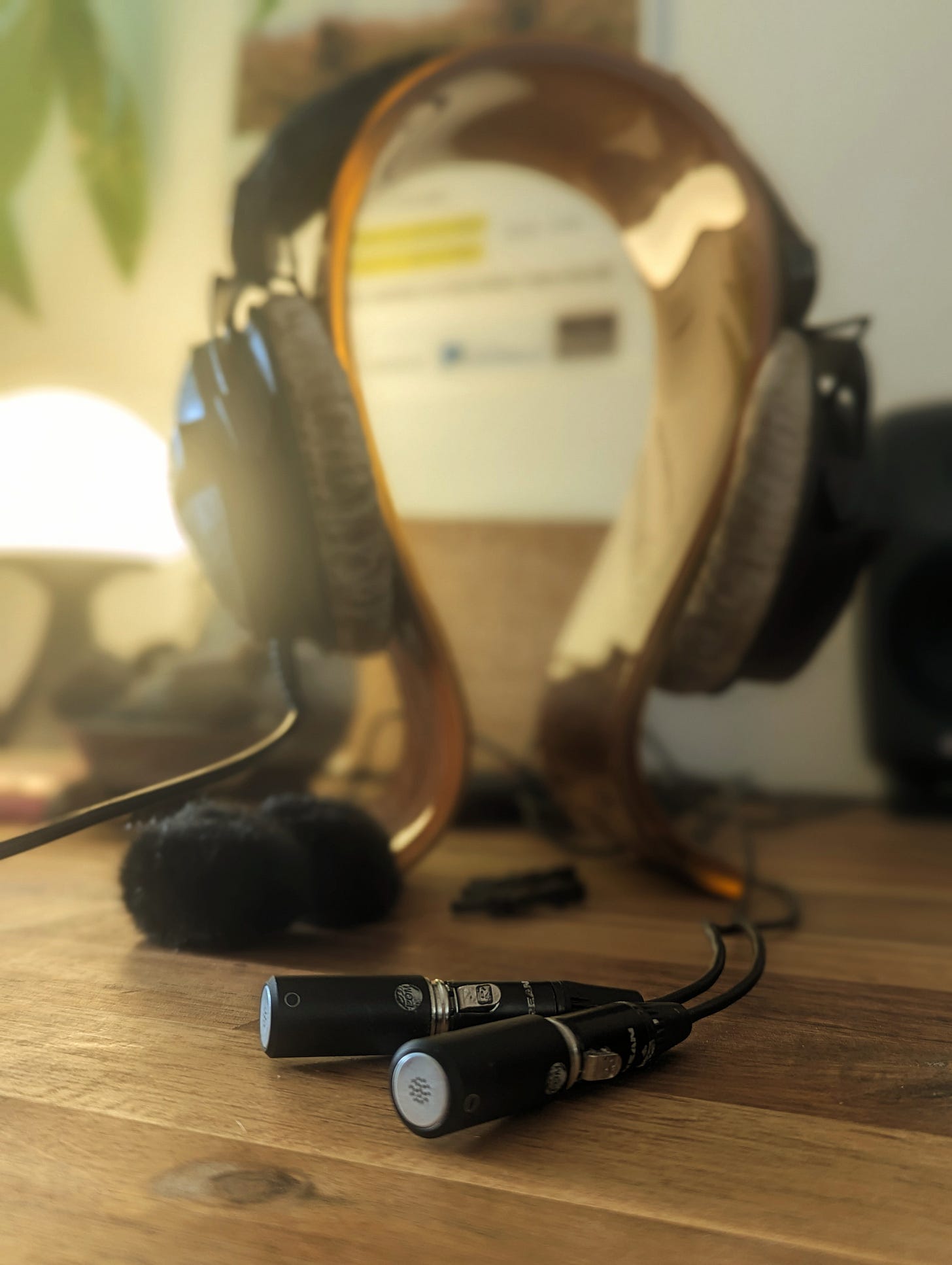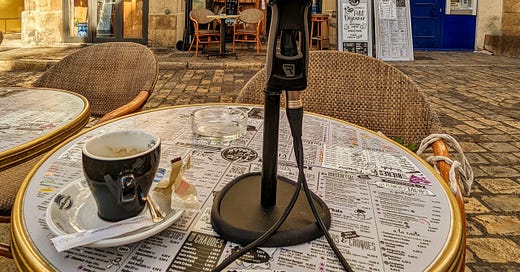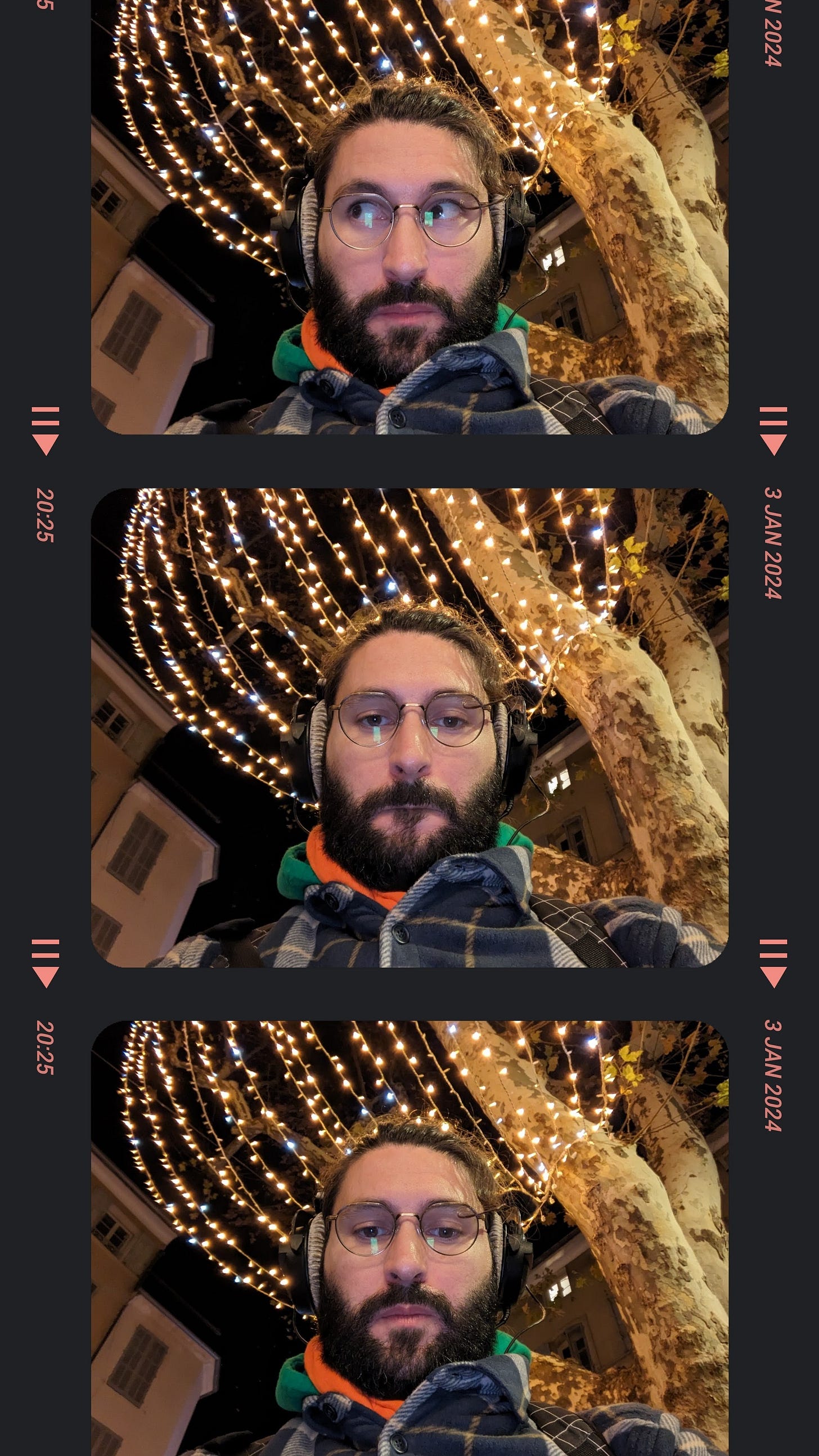Can you spot my microphones??
Look closer…
Still no…??
Stealth mode 💯 activated
Well done if you did find them (read on for the reveal). This is one of the techniques I use when I want to record in stealth mode without making myself too obvious. Just to be clear - I’m not spying… though I suppose technically you could spy quite effectively with this set up, but that is not what I’m getting at. From here it just looks like I’m wearing headphones and listening to music... but, attached with tiny crocodile clips just up above the cups of my headphones, are two wonderfully innovative and incredibly useful omnidirectional microphones - a stereo pair of LOM Uši Pro’s - made by field recordist and sound engineer Jonáš Gruska.

These tiny mics are capable of capturing an immersive reproduction of the sound field surrounding my head (otherwise referred to as a binaural recording) to give an authentic, sonic perspective of a place. This past week, I’ve been wandering around the city of Aix-en-Provence, where I currently live, collecting sounds for an upcoming sound library I’m building for a client titled French Walla Sounds. Walla is the name given to the collective sound effect of multiple people talking at the same time in a fixed location. In its simplest form - the background murmur of a crowd.
Did you know - according to one story, walla received its name during the early days of radio, when it was discovered that having several people repeat the word walla in the background was sufficient to mimic the indistinct chatter of a crowd. Often heard in film, TV and video games to create a realistic atmosphere, walla can be engineered in studios from scratch using actors or it can be sourced from raw ambience recordings made by mic-swinging mercenaries like myself.
“It’s far from an easy ride if you want to produce top quality sounds that can be considered useful for a variety of projects.”
When I tell people that I record sound effects for a living, I’m sure they might think of lightsabers or monsters, or spaceships or magic spells, or maybe even knocking twice on a wooden table with a wedding ring whilst playing a guitar chord in reverse… (that sound you hear every time you turn Netflix on…) so I’m fairly sure that walking around town recording people chatting doesn’t come across as riveting… why bother you may well ask? It might seem like a boring subject to capture, but I find the subtle complexities of the task far from banal. It’s far from an easy ride if you want to produce top quality sounds that can be considered useful for a variety of projects. Think about just how difficult it is to capture the sound of a crowd without a motorbike passing, a phone going off, someone coughing, an infant (or adult) tantrum - all undesirable imperfections in the wonderful entropy that is modern society. It would certainly be impossible. That said, there’s not really a right and wrong way for recording walla - you can just rock up with any microphone setup and you should get something that sounds correct, but when preparing a collection of 50-100+ sounds you need to think more creatively and be prepared to do some standing around, listening and investigating.
Sometimes just sitting and enjoying a good espresso works well too…
Distance, positioning, proximity to roads, reverberations, reflections, time of day - all these factors will ultimately colour the quality of your walla and offer slight variations to the final sound you are recording. Personally, I like my recordings to have a neutral character in order to maximise their appeal to sound designers and those seeking to work creatively with my sounds in their own projects. They need to sound real and recognisable. Familiar yet not too farfetched either. Here’s an example…
Where am I ?
What can you tell me about the location?
(Leave your responses in the comments section below. I’ll share the answer once I have 10 replies!!)
Taking on board and engaging with the finer details helps me to navigate the seemingly endless possibilities of recording crowds without them all sounding exactly the same. It requires a healthy reserve of determination and patience that’s for sure… but once you establish a reliable technique, and learn to trust your ears, you find that it becomes quite a natural process.
Before you know it, you may even find comfort somewhere in amongst all the noise…
≈BONUS TIPS≈
For those of you who are interested in recording your own sounds - here’s a few tips I consider when setting out :
Be sure to set your microphone and monitoring levels low. Motorbikes make for incredible feats of machinery but can be shit and destructive to both your recordings and hearing if you’re not careful!
Keep it rolling. Start by turning on your recorder and letting it run - always have extra batteries/power solutions prepped - sometimes the best content arrives before we’ve even had the thought to press record.
Don’t be shy. It’s very easy to lose yourself in the judgement that people care what you’re doing. They don’t.
TAKE NOTES!!! You think that you couldn’t possibly forget the details but you can and you almost certainly will. Take as many notes about the scene you’re recording as possible. It is invaluable information for your practice and your metadata.
🔴Record. 🔴Record. 🔴Record. Aim to record for at least 5 minutes in each location. This gives you enough content to listen through and edit if need be. Imperfections can be removed afterwards. My mantra is “you can cut less but never add more”.
If you have any questions feel free to write me directly or leave a comment below. I’m also very keen to hear more about your own recording tips, tricks & adventures! I’ve started a new chat for all those curious to connect :
A huge thank you all for taking the time to read and engage, and, as always, I hope that you enjoyed the ride!
Have a great weekend!
Take care,
🌻🌻🌻
Mat







